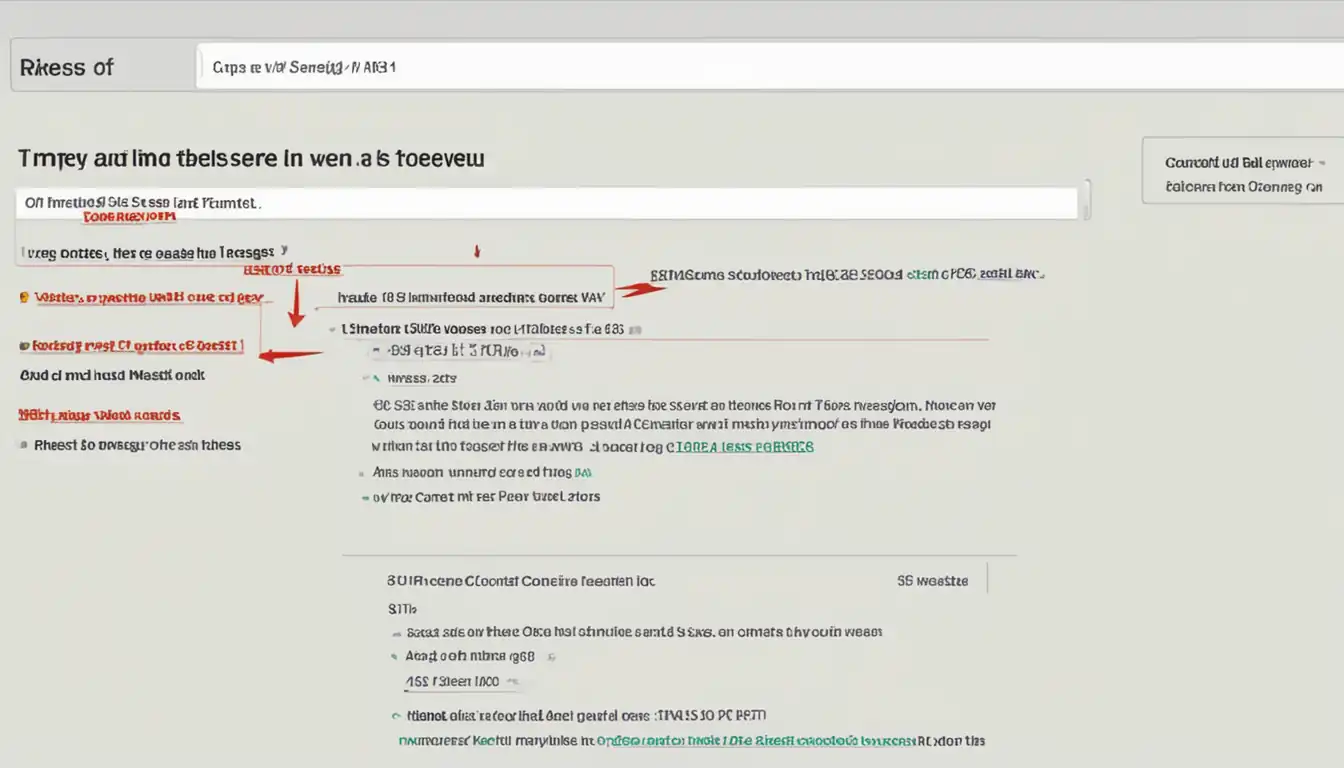Content Optimization: Elevating Your Digital Presence

Content optimization is a crucial aspect of digital marketing, and it plays a significant role in enhancing your online presence. By understanding the ins and outs of content optimization, you can effectively elevate your website's visibility and attract more organic traffic. From crafting quality content to leveraging user experience and measuring success, this comprehensive guide will equip you with the knowledge and tools needed to excel in content optimization.
Understanding Content Optimization
Content optimization is the process of making your website's content more attractive, valuable, and actionable for your audience. It involves strategically incorporating relevant keywords, improving readability, and enhancing the overall user experience. By optimizing your content, you can increase its visibility and relevance to search engines, ultimately driving more organic traffic to your website.
The Essence of Content Optimization
At its core, content optimization is about ensuring that your content meets the needs and expectations of both your audience and search engines. It's not just about stuffing keywords into your content, but rather creating high-quality, valuable, and relevant content that resonates with your target audience. This means understanding your audience's intent and delivering content that addresses their pain points, questions, and interests.
How Content Optimization Fuels SEO
Content optimization is a critical component of SEO, as it directly impacts your website's search engine rankings. By optimizing your content, you can improve its visibility and relevance to search engines, making it more likely to appear in search results for relevant queries. This, in turn, can drive more organic traffic to your website, increase engagement, and ultimately lead to more conversions.
Remember, content optimization is an ongoing process that requires continuous monitoring, analysis, and refinement to ensure that your content remains competitive and valuable in the ever-evolving digital landscape.
Crafting Quality Content
The Art of Writing for Your Audience
When it comes to creating quality content, one of the most important factors to consider is your audience. Understanding the demographics, interests, and needs of your target audience is crucial in crafting content that resonates with them. This involves conducting thorough research and developing buyer personas to gain insights into the preferences and behaviors of your audience.
Balancing Information with Engagement
While it's essential to provide valuable information to your audience, it's equally important to keep them engaged. Incorporating storytelling, visuals, and interactive elements can help capture and maintain the attention of your readers. Using a conversational tone and addressing the pain points of your audience can also enhance engagement and make your content more relatable.
In summary, crafting quality content involves writing with your audience in mind and striking a balance between providing valuable information and keeping them engaged. By understanding your audience and creating content that resonates with them, you can effectively deliver your message and achieve your content marketing goals.
Keywords: The Cornerstone of Content Optimization
Keywords are the foundation of content optimization. They are the words and phrases that people type into search engines when looking for information. Researching and integrating the right keywords into your content is crucial for improving your website's visibility and driving organic traffic.
Researching the Right Keywords
Before you start creating content, it's essential to conduct thorough keyword research. This involves identifying the terms and phrases that are relevant to your industry, products, or services, and have a high search volume. There are various tools available, such as Google Keyword Planner, SEMrush, and Ahrefs, that can help you identify the most relevant and high-performing keywords for your content.
Integrating Keywords Naturally
Once you have identified the right keywords, it's important to integrate them naturally into your content. Avoid keyword stuffing, which is the practice of overloading your content with keywords in an attempt to manipulate search engine rankings. Instead, focus on creating high-quality, valuable content that naturally incorporates your chosen keywords. This will not only improve your search engine rankings but also provide a better user experience for your audience.
The Role of Meta Tags in Content Optimization

Meta tags play a crucial role in optimizing your content for search engines. They provide valuable information about your webpage to search engines and can significantly impact your website's visibility and click-through rates.
Title Tags and Meta Descriptions: Your First Impression
Title tags and meta descriptions are the first things users see when your webpage appears in search results. They serve as your website's first impression and can influence whether users click through to your site or not. Craft compelling and relevant title tags and meta descriptions to entice users to visit your website. Keep them concise, informative, and reflective of the content on your page.
Using Header Tags to Structure Your Content
Header tags, such as H1, H2, and H3, are not only important for organizing and structuring your content for readers, but they also play a role in SEO. Search engines use header tags to understand the hierarchy and structure of your content. Utilize header tags strategically to break up your content, make it more scannable for readers, and signal the importance of different sections to search engines.
Optimizing Images for Enhanced Engagement
In today's digital age, the use of visuals in content has become increasingly important for capturing and retaining the attention of online audiences. Research has shown that content with relevant images receives 94% more views than content without. This emphasizes the need for content creators to optimize their images for enhanced engagement.
The Impact of Visuals on Content Performance
Visual content not only attracts more views but also leads to higher engagement and retention rates. When used strategically, images can effectively convey information, evoke emotions, and enhance the overall user experience. This, in turn, can lead to longer page visits, lower bounce rates, and increased sharing of the content on social media platforms. Therefore, it is crucial for content creators to understand the impact of visuals on content performance and leverage this knowledge to their advantage.
Best Practices for Image Alt Text
One of the key aspects of optimizing images for enhanced engagement is the use of alt text. Alt text, or alternative text, is a brief description of an image that is displayed when the image cannot be loaded. It not only improves accessibility for visually impaired users but also provides search engines with valuable information about the content of the image. When creating alt text, it is important to be descriptive and concise, using relevant keywords to accurately represent the image. Additionally, it is recommended to avoid using generic phrases such as "image" or "photo" and instead provide specific details that align with the context of the content. By following best practices for image alt text, content creators can improve the accessibility and search engine optimization of their visual content, ultimately leading to enhanced engagement from online audiences.
Leveraging User Experience for Content Optimization
When it comes to optimizing content for SEO, it's essential to consider the user experience. After all, search engines prioritize websites that provide a positive experience for their users. In this section, we'll explore two critical aspects of user experience that can significantly impact your content optimization efforts.
Page Load Speed: The Need for Speed in SEO
One of the most crucial factors in user experience is page load speed. In today's fast-paced digital world, users expect websites to load quickly. In fact, Google has explicitly stated that page speed is a ranking factor for search results. Slow-loading pages not only frustrate users but also lead to higher bounce rates, which can negatively impact your SEO efforts.
To optimize your content for page load speed, consider the following:
- Compressing images and other media files to reduce file sizes
- Minimizing HTTP requests by combining CSS and JavaScript files
- Utilizing browser caching to store static resources
By prioritizing page load speed, you can improve the overall user experience and boost your SEO performance.
Mobile-Friendliness: Catering to the On-the-Go User
With the increasing use of mobile devices, it's more important than ever to ensure that your website is mobile-friendly. Google's mobile-first indexing means that the mobile version of your site is the primary version used for indexing and ranking. If your site is not optimized for mobile, you could be missing out on valuable traffic and rankings.
To optimize your content for mobile-friendliness, consider the following:
- Using responsive design to ensure your site looks and functions well on all devices
- Prioritizing mobile usability by making buttons and links easily tappable
- Avoiding intrusive interstitials that can hinder the user experience on mobile devices
By catering to the on-the-go user, you can enhance the overall user experience and improve your SEO performance.
Internal Linking Strategies
Internal linking is a crucial aspect of SEO that is often overlooked. By strategically linking to other pages within your website, you can improve the user experience, distribute page authority, and signal the importance of certain pages to search engines.
The Power of Internal Links in SEO
Internal links play a significant role in helping search engines understand the structure and hierarchy of your website. They also help to establish the relevance and authority of your pages. When done correctly, internal linking can improve the overall visibility and ranking of your website in search engine results.
Crafting Effective Anchor Text
When creating internal links, it's essential to use descriptive and relevant anchor text. Using generic phrases like "click here" or "read more" provides little context to search engines and users. Instead, use anchor text that accurately describes the content of the linked page. This not only helps with SEO but also improves the user experience by providing clear expectations of where the link will lead.
By incorporating a variety of anchor text and linking to relevant pages, you can create a strong internal linking structure that enhances the overall SEO performance of your website.
Content Freshness and Update Frequency

In the world of SEO, content freshness plays a crucial role in determining the relevance and authority of a website. Search engines like Google prioritize fresh and updated content, as it indicates that the website is actively maintained and provides value to its visitors.
The Importance of Staying Current
Regularly updating your content not only signals to search engines that your website is active, but it also provides an opportunity to incorporate new keywords, address current trends, and improve the overall quality of your content. This can lead to higher search engine rankings and increased organic traffic.
Revamping Old Content for New Gains
Revamping old content is a cost-effective way to improve your website's SEO performance. By updating outdated information, adding new insights, and optimizing for relevant keywords, you can breathe new life into existing content and attract more visitors. Additionally, repurposing old content into different formats such as videos, infographics, or podcasts can further enhance its value and appeal to a wider audience.
Remember, freshness and update frequency are key factors in maintaining a competitive edge in the ever-evolving landscape of SEO.
Social Signals and Content Optimization
When it comes to optimizing content for search engines, social signals play a crucial role in amplifying the reach of your content. Social shares are a strong indicator to search engines that your content is valuable and engaging. When your content is shared across various social media platforms, it not only increases visibility but also drives traffic to your website.
To encourage engagement through social media, it's important to create shareable content that resonates with your audience. This can include informative articles, entertaining videos, or thought-provoking infographics. By understanding your target audience and their preferences, you can tailor your content to encourage social shares and ultimately improve your search engine rankings.
In addition to creating shareable content, it's also important to actively engage with your audience on social media. Responding to comments, asking for feedback, and initiating conversations can all contribute to increased social shares and improved content optimization. By building a strong social media presence and fostering a community around your brand, you can leverage social signals to enhance the visibility and impact of your content.
Measuring Content Optimization Success
When it comes to measuring the success of your content optimization efforts, it's important to have a clear understanding of the key performance indicators (KPIs) that will indicate whether your strategy is working or not. These KPIs will help you track the impact of your content optimization efforts and make data-driven decisions to improve your strategy.
Key Performance Indicators for Content Optimization
Organic Traffic: One of the most important KPIs for content optimization is the increase in organic traffic to your website. This indicates that your optimized content is ranking higher in search engine results and attracting more visitors.
Keyword Rankings: Monitoring the rankings of your target keywords is crucial for measuring the success of your content optimization efforts. An increase in keyword rankings indicates that your content is becoming more visible to your target audience.
Engagement Metrics: Tracking engagement metrics such as time on page, bounce rate, and click-through rate can provide insights into how well your optimized content is resonating with your audience.
Conversions: Ultimately, the goal of content optimization is to drive conversions. Tracking the number of leads, sign-ups, or sales generated from your optimized content is a key KPI for measuring success.
Tools for Tracking Content Optimization Progress
Google Analytics: This powerful tool provides in-depth insights into website traffic, user behavior, and conversion metrics, making it essential for tracking the success of your content optimization efforts.
SEMrush: With features for keyword research, rank tracking, and content optimization, SEMrush is a valuable tool for monitoring keyword rankings and identifying opportunities for improvement.
Ahrefs: Ahrefs offers comprehensive features for backlink analysis, keyword research, and content optimization, making it a valuable tool for tracking the success of your content optimization strategy.
By utilizing these KPIs and tools, you can effectively measure the success of your content optimization efforts and make data-driven decisions to improve your strategy.
Advanced Content Optimization Techniques
When it comes to advanced content optimization techniques, two key strategies stand out: structured data and schema markup, and the role of artificial intelligence in content optimization.
Structured Data and Schema Markup
Structured data and schema markup are essential for helping search engines understand the content of your website. By using structured data, you can provide additional context to search engines, which can lead to rich snippets and enhanced search results. This can improve the visibility and click-through rates of your content.
When implementing structured data and schema markup, it's important to use the appropriate markup for different types of content, such as articles, recipes, events, and more. This can help search engines better understand the specific details of your content and display it in a more visually appealing way in search results.
The Role of Artificial Intelligence in Content Optimization
Artificial intelligence (AI) plays a significant role in content optimization by helping to analyze and understand user behavior, preferences, and intent. AI-powered tools can provide valuable insights into keyword research, content performance, and user engagement, allowing for more targeted and effective content optimization strategies.
AI can also be used to automate content creation, optimization, and personalization, allowing for more efficient and scalable content strategies. By leveraging AI, content marketers can gain a deeper understanding of their audience and create more relevant and engaging content that resonates with their target audience.
In conclusion, structured data and schema markup, along with the role of artificial intelligence, are advanced content optimization techniques that can significantly improve the visibility, relevance, and effectiveness of your content. By implementing these strategies, you can enhance your content's performance and drive better results for your website.
When it comes to content optimization, there are a few common challenges that many website owners face. One of the most prevalent issues is dealing with thin content. Thin content refers to pages that have little to no valuable information for users. This can negatively impact your SEO efforts, as search engines prioritize content that provides value to users.
To address thin content issues, it's important to conduct a thorough content audit. Identify pages with thin content and either beef them up with more valuable information or consider consolidating them with other relevant pages. Additionally, creating a content strategy that focuses on providing comprehensive and in-depth information on relevant topics can help prevent thin content from becoming a recurring issue.
Another challenge that website owners often encounter is the temptation to engage in keyword stuffing. Keyword stuffing is the practice of overloading content with keywords in an attempt to manipulate search engine rankings. However, this tactic is outdated and can result in penalties from search engines.
To navigate the pitfalls of keyword stuffing, focus on creating high-quality, relevant content that naturally incorporates keywords. Utilize long-tail keywords and variations of your target keywords to create a more natural and user-friendly experience. Remember, the goal is to provide valuable information to your audience, not to manipulate search engine rankings.
- Use relevant keywords naturally throughout the content
- Create high-quality, engaging, and informative content
- Structure content for easy readability and user experience
- Optimize meta tags, titles, and descriptions for search engines
- Incorporate internal and external links strategically
- Utilize multimedia elements to enhance the content
- Regularly update and refresh existing content to maintain relevance
When it comes to content optimization, it's essential to follow a checklist for content excellence. This checklist includes using relevant keywords naturally throughout the content, creating high-quality, engaging, and informative content, structuring content for easy readability and user experience, optimizing meta tags, titles, and descriptions for search engines, incorporating internal and external links strategically, and utilizing multimedia elements to enhance the content. Additionally, regularly updating and refreshing existing content is crucial to maintaining relevance and visibility in search engine results.
It's also important to avoid over-optimization by striking the right balance. Over-optimizing content can lead to penalties from search engines and a poor user experience. By focusing on providing valuable and relevant content to the audience, while incorporating optimization best practices, you can achieve the right balance and improve your search engine rankings.
Case Studies: Content Optimization in Action

When it comes to content optimization, seeing real-life examples can be incredibly helpful. In this section, we'll explore some success stories from various industries, as well as lessons learned from content optimization missteps.
Success Stories from Various Industries
E-commerce: Company X saw a 40% increase in organic traffic after implementing a comprehensive content optimization strategy. By focusing on long-tail keywords and creating high-quality, informative product descriptions, they were able to improve their search engine rankings and attract more potential customers.
Healthcare: Hospital Y revamped their website content to better align with user search intent. As a result, they experienced a 25% increase in appointment bookings and a significant boost in online visibility. By understanding their audience's needs and tailoring their content accordingly, they were able to achieve impressive results.
Technology: Software company Z utilized a combination of keyword research and content updates to improve their blog's performance. Their organic traffic doubled within six months, and they saw a notable increase in leads generated through their website. This demonstrates the power of strategic content optimization in the tech industry.
Lessons Learned from Content Optimization Missteps
Over-optimization: Company A went overboard with keyword stuffing and ended up being penalized by search engines. This serves as a cautionary tale about the dangers of prioritizing search engines over the user experience. It's essential to find the right balance and focus on creating valuable, user-friendly content.
Lack of Regular Updates: Business B neglected their website content for an extended period, leading to a decline in search visibility and user engagement. This highlights the importance of ongoing content optimization efforts to maintain and improve organic performance over time.
Ignoring Mobile Optimization: Company C failed to optimize their content for mobile users, resulting in a significant loss of potential traffic and conversions. As mobile usage continues to rise, it's crucial to ensure that content is accessible and engaging across all devices.
By examining these case studies, we can gain valuable insights into the impact of content optimization on various industries and learn from both successful implementations and common missteps.
Future-Proofing Your Content Optimization Strategy
In the ever-changing landscape of SEO, it's crucial to future-proof your content optimization strategy to stay ahead of algorithm changes and embrace new trends. Here are some key strategies to consider:
Staying Ahead of Algorithm Changes
The SEO world is constantly evolving, with search engines updating their algorithms regularly. To future-proof your content optimization strategy, it's essential to stay ahead of these changes. Keep an eye on industry news, follow reputable SEO blogs, and attend webinars to stay informed about the latest algorithm updates. Adapting to these changes quickly can give you a competitive edge in the search results.
Embracing New Trends in Content Optimization
As technology and user behavior evolve, new trends in content optimization emerge. Embracing these trends can help future-proof your strategy and ensure that your content remains relevant and engaging. Keep an eye on emerging technologies, such as voice search and AI, and consider how they can be integrated into your content optimization efforts. By staying ahead of the curve, you can position your content for success in the long term.
Conclusion
In conclusion, content optimization is an ongoing process that requires dedication and strategic planning. By implementing the best practices and staying ahead of industry trends, you can future-proof your content optimization strategy and achieve long-term success. Whether you're a seasoned marketer or just starting, mastering the art of content optimization will undoubtedly set you apart in the digital landscape.